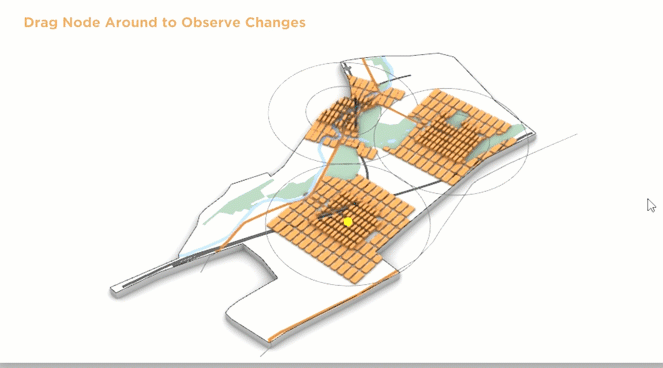It will open up a whole new world for you
Around 5 years ago, before I even started university I went to a guest lecture on the mathematics of general relativity with a friend. The professor talked about one of the components in Einstein’s field equations. After 5 minutes of calculations, the components comes together nicely and conserves both momentum and energy. I smiled. He saw me smiling, pointed at me and said “Haha! This guy gets it! It’s beautiful isn’t it!” Everyone turned to look at me, it was at this moment that I knew, I was destined to dive into the complex theories of mathematics and see the intrinsic beauty of… pfffft, nahhh
I ended up doing architecture. But who knew that I would come around to mathematics again! During my masters in the MSA (Manchester School of Architecture) I had the chance to join one of the most cutting edge studio in architecture (the CPU_AI atelier), learning about parametric design, how AI, big data and ML can help us in city design, town planning and so on. It was in this studio that I learnt about how parametric design is actually not computers designing a building for you (I wish…) but a just new set of tools. And I kid you not, its all about maths, logic and a bit of physics.
The Definition
Let’s start with the definition of what the word even means. The word parametric is actually from ancient Greek and has 2 parts to it— “para” means beside or alongside while “metric” evolved from “métron” which means to measure — to measure alongside, meaning a variable that can affect the outcome or subsequent calculations in a function. If the equation y=mx+c is said to be parametric equation, then“x” is a variable, or a parameter that can affect the outcome of “y”, given “m” and “c” are constants, which “y” reacts parametrically.
In architecture, parametric design means using parameters in a set of rule(s) or algorithm(s) to control and manipulate the outcome i.e. your design intent, creating e.g. complex geometries or structures.
Yet, when people talk about parametric architecture, they usually are talking about the buildings with almost impossible curves and shapes, usually referred to as parametric architectural form finding. Even among architects, parametric design/ architecture usually point their mind this way. Notable architects include Zaha Hadid, Zaha Hadid and Zaha Hadid. Her work is so iconic that you do not have to be an architect or know anything about architecture to know her (see images below). She is famous outside of the industry. Sadly this legend had passed away in 2016, leaving her legacy behind.



So who started this then? Actually, parametric design was invented long before even the invention of computers, by a man which I am sure everyone have heard about his name if you ever visited Barcelona — Antoni Gaudi. He was arguably the first parametric designer, who was wayyy ahead of his time. His obsession in nature led him to find ways to mimic nature in his buildings. With his #bigbrain he was able to devise a method of putting weights on hanging ropes to let it drape, and by manipulating the weights he was able to get the curves he desired. Which then he places a mirror underneath to get the reverse of the parabolic shape and thus achieving his magnificent la Sagrada Familia.


However, this is not the only type. Parametric design can help us achieve so much more and it doesn’t have to be limited to form finding. For example, if you want to design a floor plan in a building, and you are frustrated not knowing which location to put the main entrance as there is a main road on both side of your building, you can design a system that takes in the parameter x, which records “the amount of people on each side of the street in front of the building” and the entrance is put on whichever side has more people (obviously this is an overcomplicated way to decide where to put your entrance but just go along with me). But what if the amount of people changes by the hour? With parametric design you can easily factor in a new parameter (i.e. time) to create a new plan. What if there are certain fire regulation that requires a door per 50 people coming in? You can now easily hook up the amount of doors with your parameter x in the system. What if a new shopping mall opened near your building and there are suddenly more people on one side of the street? What if your developer tells you that an apple store in going to open in this building and you are suddenly expecting 3x more people?
You get the idea, using a parametric design method allows a tailored solution to a wide amount of problems or design issues. Welcome to the real parametric design.
However, parametric design is still rejected by many people in the architecture world, referring it to be computer designed architecture that lacks the warmth of a human touch. That cannot be more wrong. In fact, by saying that these architects are simply revealing they have no idea what parametric architecture is. Let’s revisit the definition of parametric architecture:
In architecture, parametric design means using parameters in a set of rule(s) or algorithm(s) to control and manipulate the outcome i.e. your design intent, creating e.g. complex geometries or structures.
using parameters in a set of rule(s) or algorithm(s) to control and manipulate the outcome
The use of a parameter is just the first step in creating a parametric design, a parameter is just a shell without anything. If you as a designer does not create the environment for it to interact (the rules or algorithms), a parameter is meaningless. You don’t just type in the computer “a building that twists” and Bibbidi-bobbidi-boo a design comes out. How much does your building curves, where does it curves, these are all questions you need to solve in your algorithm in order for the parameter to mean anything, in order for you to design your building.
Algorithms, parameters, rules, they all sound complicated, let me explain:

In the image above, A & B are both parameters, they can be anything. As we understood above, without any rule(s) or algorithm(s) the parameters are meaningless. But when we add a rule/ algorithm in — there is suddenly a meaning to the parameters.

In the second image both A & B have meaning as they are the multiplier and multiplicand. The rule/ algorithm in this instance is the multiplication. Through the algorithm we get the result of 10. As we stack these algorithms up they form a bigger and more complicated algorithm that can take into account more issues, address more design challenges and so on, take a look:

This was my algorithm to model the emergence of a city based on a point of transport node using a transit oriented development urban strategy. It may sound complex but it is just a lot of considerations of different factors that each lead to lots of small algorithms that combine and become a complicated algorithm solving real world issues. Have a look at the results:

Now you understand what parametric architecture really means. It is not a button you click to “generate” architecture but a tool, and the work and thinking you are required to do ahead is so much more compared to traditional methods.
Parametricism is just a new tool for architects
The evolution of tools in architecture had been ever-changing, from stone tablets in ancient Rome to pen and paper on a drawing board, to computer aided design (CAD) software, and now to parametricism. Imagine people rejecting cad softwares and demand you to return to the drawing board to retain the authenticity, you would think they’re crazy. Now imagine people rejecting parametric architecture and demand you to return to using cad all day. Who’s crazy now?
It is a means not an end, and it unlocks a whole new world and a whole new way of thinking.
I am planning to write more about the future of architecture, follow me to read them first!
Thanks for reading. I now work in architectural digital innovation. Feel free to get in touch or check out my website.
